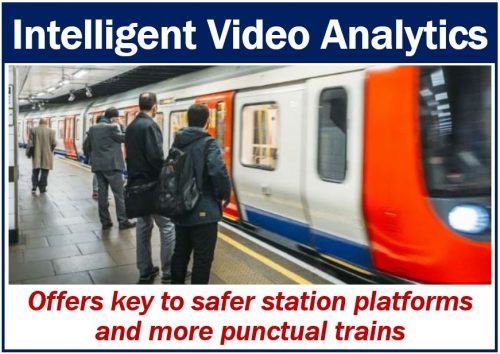Intelligent video analytics technology that Lancaster University researchers developed could help trains run on time. The technology could also improve safety at metro (underground/subway) and train platforms.
Their analytics technology can use existing CCTV cameras that are on-board trains and on platforms. It provides real-time information to train drivers and other staff when there are passengers in certain risk areas.
In the United Kingdom, the number of train passengers who die or get injured is relatively low. As in other countries, the most dangerous moments for them are when they get on and off trains at platforms.
New intelligent video analytics technology
The system uses a new intelligent video analytics technology that Lancaster researchers developed with Digital Rail Ltd (Digital Rail). Digital Rail, which is based in Lancaster, is a rail safety technology SME (small-to-medium size enterprise).
The technology can autonomously detect objects that stand out in the background. It can detect, for example, bicycles, luggage, pushchairs, mobility scooters, and people. It estimates their position in relation to the coach doors, rails, and the yellow line on the platform.

The technology then processes this data across several different cameras along a platform within trains. Staff and passengers subsequently have valuable information in real time. For those interested in delving deeper into the capabilities of modern surveillance, the advancements in video analytics software have revolutionized not only transportation safety but also various forensic applications.
The system knows when passengers have moved between the yellow line on the platform and the train. It alerts drivers and shows them at which door the potential problem is happening. Drivers and rail staff can use this information to check the relevant platform and train cameras to see whether anybody is trapped.
System helps relieve train drivers’ stress
Professor Plamen Angelov said:”
“This system can help the working experience of drivers, going some way to relieve their stress and pressure by assisting them in looking out for risks around the train and making accurate decisions.”
“Gap falls, and ‘trap and drag’ scenarios can be detected more accurately and by using this system there is an improved chance that drivers and platform staff will notice these incidents before it’s too late.”
Professor Angelov works at Lancaster’s School of Computing & Communications. He is also Chair of Intelligent Systems at Lancaster University.
This analytics technology can also measure how busy specific carriage doors are while the train is moving. In other words, before the train arrives at a platform. There are cameras inside the carriages that identify how many passengers are waiting to alight.
The system uses the cameras on the platform to determine how many passengers are waiting for the train to arrive.
By combining the data from the two sets of cameras, the analytics technology can predict which doors are likely to be busy. It can also tell which doors are likely to offer passengers smoother boarding.
System useful for passengers
This information is useful for waiting passengers. They could receive the information through illuminated signs using, for example, a traffic light color system. Passengers would then know what part of the platform to avoid or the best places to stand.
The system would allow passengers to board trains more quickly. Also, the system would help reduce how long each train has to wait at the platform.
What the new technology does – highlights
- It detects where the passengers who are waiting for the train are (on the platform).
- Sends alerts to rail staff, drivers, and other stakeholders if somebody is stuck in the gap.
- Measures how many passengers there are on the platform.
- Measures the number of passengers on the train.
- Does not need new camera infrastructure (uses what is already there).
- Processes all the data in real time on, for example, a Raspberry Pi or other tiny computer.
Shortening dwell times
How long trains wait at the station has a significant effect on punctuality and, consequently, network capacity. We use the term ‘train dwell times’ when referring to how long trains wait at the platform motionless.
Professor Angelov said:
“Our system will help staff to maintain on-time services by shortening passenger boarding dwell times, improving the passenger experience, diminish station bottlenecks and further improving safety by reducing crowds at stations.”
The new analytics technology runs on standard computing equipment. Its creators say it is easy to miniaturize it. It has the capability of detecting both stationary and moving objects. This feature is critical because it can tell different types of objects apart, such as passengers, luggage, and bicycles. Specifically, objects that might cause congestion around doors.
The researchers have developed and tested the system using archive real-life CCTV footage from carriages and platforms on the British rail network. They now plan to further develop their software by testing it in real-time on trains and platforms.

